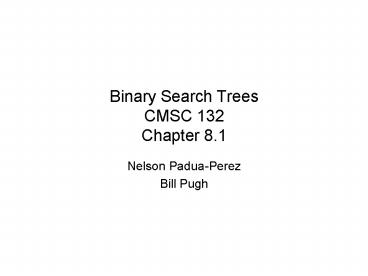Binary Search Trees CMSC 132 Chapter 8.1 - PowerPoint PPT Presentation
1 / 14
Title:
Binary Search Trees CMSC 132 Chapter 8.1
Description:
Books, etc., often talk about each node of a binary tree just containing a key. Search trees ... hard/tricky case. 7. Deleting the root of a binary search tree ... – PowerPoint PPT presentation
Number of Views:48
Avg rating:3.0/5.0
Title: Binary Search Trees CMSC 132 Chapter 8.1
1
Binary Search TreesCMSC 132Chapter 8.1
- Nelson Padua-Perez
- Bill Pugh
2
Binary Search Tree
3
Building maps with binary search trees
- Books, etc., often talk about each node of a
binary tree just containing a key - Search trees are often used to implement maps
- each non-empty node contains a key, a value, and
left and right subtrees - What the ?!?! is the generic type ltK extends
ComparableltKgtgt - Denotes any type K that can be compared to Ks
- e.g., Strings can be comparedTod Strings, but
Strings cannot be compareTod Integer
4
Searching a binary tree for a value X
- Is the tree empty?
- if so, then X is not present
- If the key at the root of the tree
- equal to X
- X is present
- greater than X
- check to see if X present in left subtree
- less than X
- check to see if X present in right subtree
5
Inserting X into a binary tree (Listing 8.4)
- Define the insertion function to return a new
tree - If tree is empty, return a new tree containing
just X - If the key at the root of the tree
- equal to X
- X is already represent present, just return
existing tree - greater than X
- replace left subtree with result of inserting X
into left subtree - return existing tree
- less than X
- replace right subtree with result of inserting X
into right subtree - return existing tree
6
Deleting X into a binary tree (Listing 8.4)
- Define the deletion function to return a new tree
- If tree is empty, X isnt in tree, return empty
tree - If the key at the root of the tree
- greater than X
- replace left subtree with result of deleting X
from left subtree - return existing tree
- less than X
- replace right subtree with result of deleting X
from right subtree - return existing tree
- equal to X
- hard/tricky case
7
Deleting the root of a binary search tree
- If one of the subtrees is empty can just return
the other subtree - Otherwise
- find the maximum element from the left subtree
- delete it from the left subtree
- make new tree, with the maximum element from the
left subtree
8
Deleting 23
23
35
17
52
20
27
5
3
13
9
Deleting 23 consider subtrees
23
35
17
52
20
27
5
3
13
10
Deleting maximum element from left subtree
35
20
17
52
27
5
3
13
11
Form new tree, from resulting left subtree and
original right subtree
20
35
17
52
27
5
3
13
12
Binary search tree project
- Project 6 has been posted to your linuxlab
repository - Recursive, polymorphic binary search tree
- used to implement a map
- What do we mean by polymorphic?
- implement two subtypes of Tree EmptyTree and
NonEmptyTree - We use EmptyTree, rather than null to represent
the empty tree - Invoke methods on tree nodes, get empty or
nonempty functionality
13
Recursive, polymorphic linked lists
- Give you code for linked lists that uses the same
concept - Keys are kept in sorted order
- Have an interface List, and subtypes EmptyList
and NonEmptyList
14
compareTo
- I always have to look up which way this works
- Invoke a.compareTo(b)
- if a.compareTo(b) 0, then a b
- if a.compareTo(b) lt 0, then a lt b
- if a.compareTo(b) gt 0, then a gt b

